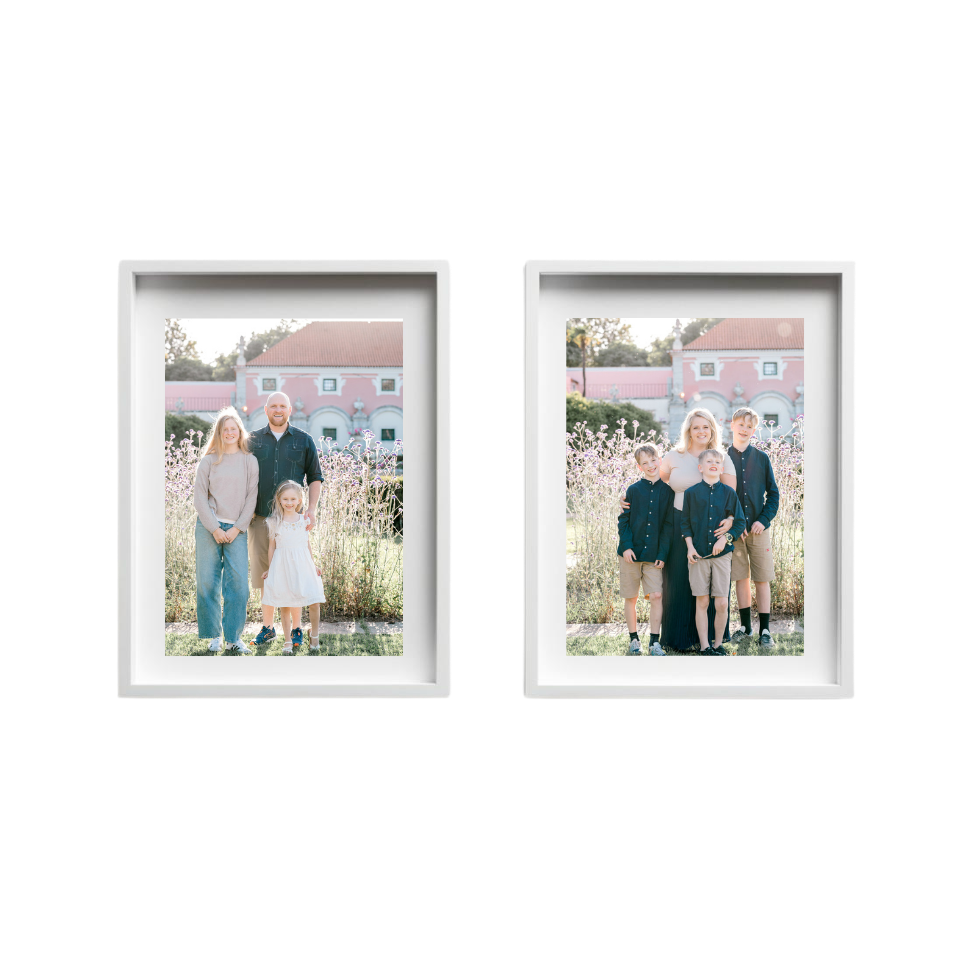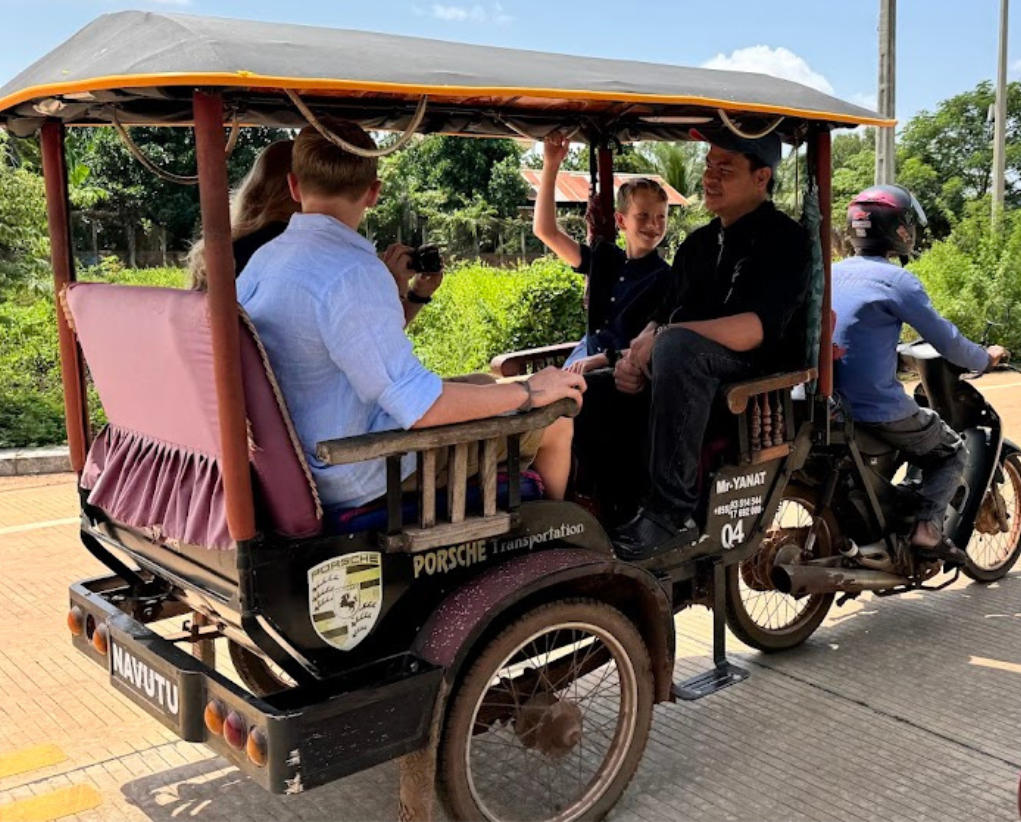

Cambodia! Country 52 for us as a family of seven. I was so excited to visit there and see the famous Angkor Wat. Most likely, you are going to be visiting Siem Reap also to visit the famous Angkor Wat! This UNESCO site brought us to Cambodia.
However, I was pleasantly surprised to find that Siem Reap offers other great options to families besides just this famous temple. We love Southeast Asia for many reasons (great food, great prices, family foot massages) and highly recommend families explore this part of the world.
We spent three months living in Thailand in 2019, and Siem Reap felt a lot like the Thailand I remembered. Thailand is more built up now, but Siem Reap reminded me very much of our old Thailand experiences. It is still a little more raw around the edges, which I appreciate.
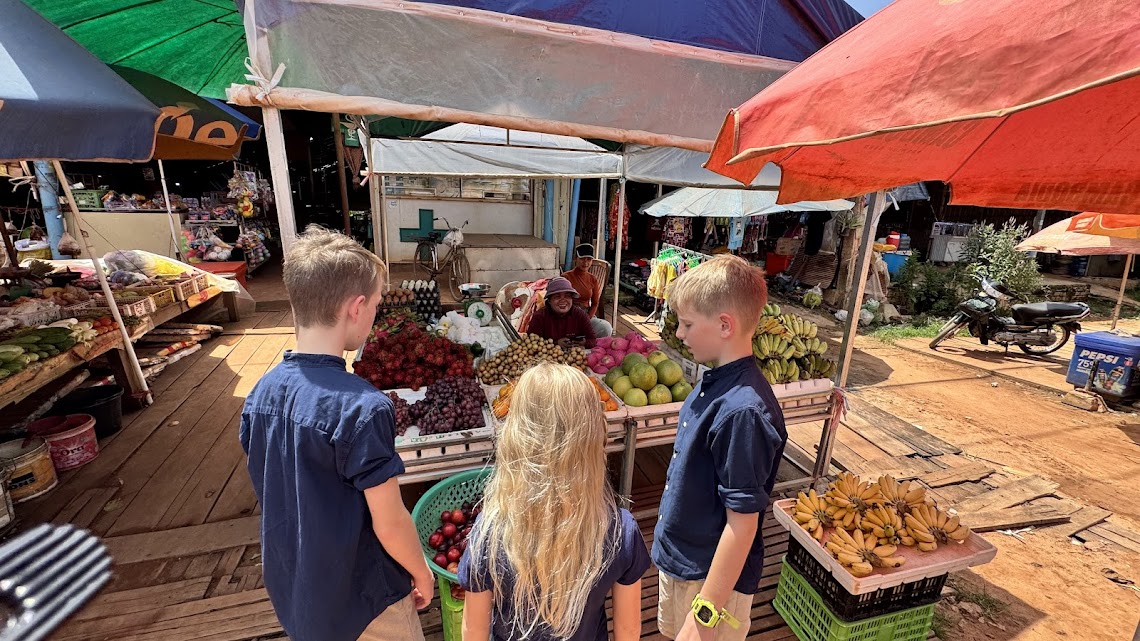
Traveling to Cambodia made us a bit nervous, as our good friend and business partner had lived there for a couple of years as a missionary. He told us he got quite sick; however, this was 20 years ago. Guess what? We didn’t get sick AT ALL and loved our visit! I’d happily go back! Of course, we were very careful with drinking only bottled or filtered water.
Thankfully, we found Siem Reap to be a great balance of local flair and tourist hotspot, which is the best combination in my opinion. You can get a good taste of Asia and have fun without breaking the bank!
You can also enjoy local foods without spending days in the bathroom. Years of publicity and education have greatly reduced the risks of illness in many of these countries! Be smart too about not drinking any unfiltered and unbottled water (including when you brush your teeth), stick to cooked foods and avoid raw fruits and vegetables that are not peeled.
While our time in Siem Reap was quite short (only three days!), we made the most of it. Check out some of the fun options to enjoy there with kids:
When I heard the word rat, I was almost out, but I decided to ask around. This was the best thing we did in Siem Reap. The kids enjoyed it way more than Angkor Wat!
Even if you are a bit nervous about rats (like me), you must go to this! These specially trained rats help to detect landmines, which can be a big problem in various countries, including Cambodia.
At the visitors center, you can read all about them, then be shown demonstrations on what landmines are and how these rats detect them. You’ll even be able to interact with one. Highly recommend!
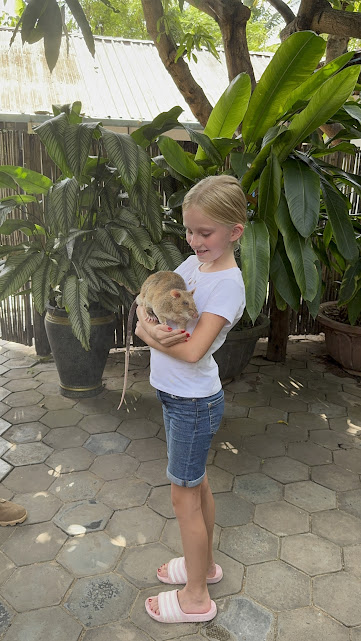
The highlight of a visit is the guided tour, which lasts around 45 to 60 minutes. During this time, you’ll gain a fascinating insight into APOPO’s mission. The experience begins with a historical perspective on the landmine crisis in Cambodia, followed by an inside look at how the HeroRATs are trained, from their early socialization to the highly specialized process of scent detection.
Visitors can then enjoy a live demonstration where a rat locates a simulated landmine, and the tour even ends with the chance to hold a rat for a memorable photo.
Apopo tickets typically cost about $10 USD per person, and children under 10 are often admitted free. Every ticket directly supports APOPO’s demining and disease detection work. While it’s possible to pay upon arrival, securing a spot online ahead of time is strongly recommended, especially during peak travel seasons.
The visitor center is open daily, but timing your visit can make a big difference. Mornings are often the most pleasant, as you’ll avoid the midday heat. The tour is outside and there is no A/C (although they do have fans), so it is HOT. Tours run throughout the day, with the final one usually scheduled for late afternoon.
And then, of course, there are the HeroRATs themselves. These clever animals are naturally most active in the morning. Their main training sessions take place from 6:30 a.m. to 8:30 a.m. to avoid the heat, though visitors don’t see this fieldwork firsthand. The live demonstrations, however, offer a vivid sense of their extraordinary skills.
The season also matters. Cambodia’s dry season, from November to March, is both the most popular and the busiest time of year.
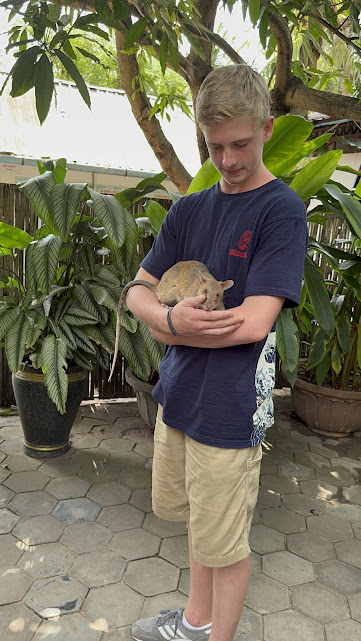
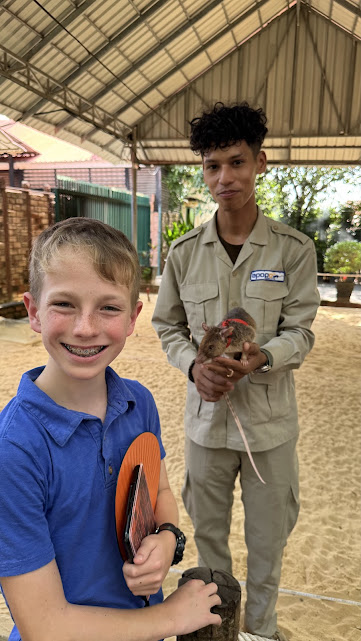
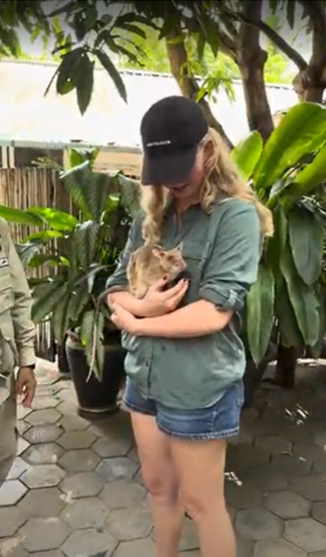
Planning ahead is always a good idea. Booking online ensures you won’t be waiting in line, especially during high season. Once you’re there, take advantage of the expertise of the guides, ask questions about the rats, APOPO’s mission or Cambodia’s history with landmines.
Because the early part of the tour often takes place outside, staying hydrated is essential. Bring water so you can enjoy the experience comfortably.
Finally, consider extending your impact beyond the tour itself. Every ticket helps, but there are more ways to support the cause. Donations, no matter how small, contribute to clearing land from dangerous landmines. Sponsoring, or “adopting”, a HeroRAT allows you to follow its progress, and the gift shop offers meaningful keepsakes and locally made items that also give back to the community.
Night markets are a global phenomenon, alive with energy, delicious street food, handmade crafts and a buzzing social atmosphere. Each one has its own character, but with a little preparation, you can make the most of your visit and enjoy the experience to the fullest.
The riverside night market, for example, is large and fun, with many restaurants open and plentiful street food. I took my girls for a mani/pedi ($15 each) and foot massage, which was a big win. You can do a little shopping and enjoy the evening.
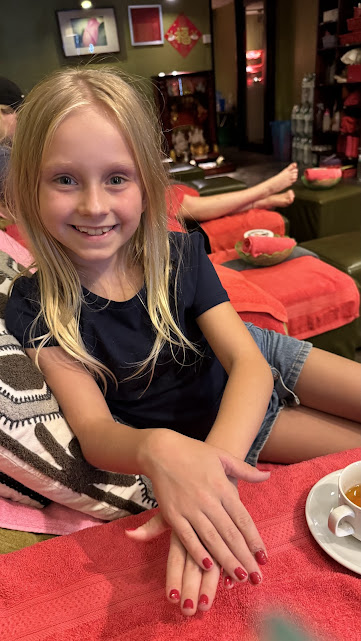
If you’re looking for fewer crowds, arriving right when the market opens in the early evening gives you more space to browse and a chance to grab food before the dinner rush begins around 8 p.m. Plus, most people will be a lot more sober! It’s more kid-friendly to go earlier in the evening.
For the full, lively atmosphere, head in later, between 8 p.m. and 10 p.m., when the market is at its peak with music, food, and bustling activity. If a quieter experience appeals to you, weekdays tend to be calmer than weekends, when the market is busiest. One of the tours is:
This evening food tour in Siem Reap takes you on a flavorful exploration of the city’s vibrant food scene. Over the course of the tour, you’ll taste around 10 different Khmer specialties, including noodles, spring rolls, tropical fruit, barbecued dishes, and even local delicacies like insects. Each stop offers something unique, from street vendors to hidden eateries, giving you a well-rounded taste of Cambodian cuisine.
The experience lasts approximately four to four and a half hours, starting with hotel pickup at 5:00 p.m. and concluding around 9:00 p.m. Along the way, you’ll wander through the bustling night market, enjoy stops at small local restaurants, and end the evening at a neighborhood bar with drinks.
Guided by an expert familiar with Khmer flavors and traditions, the tour ensures both authenticity and food safety. With its small-group format, it feels personal and immersive, allowing you to experience Siem Reap like a local. The price begins at $35 per person, which includes all tastings, beverages, bottled water and hotel transfers.
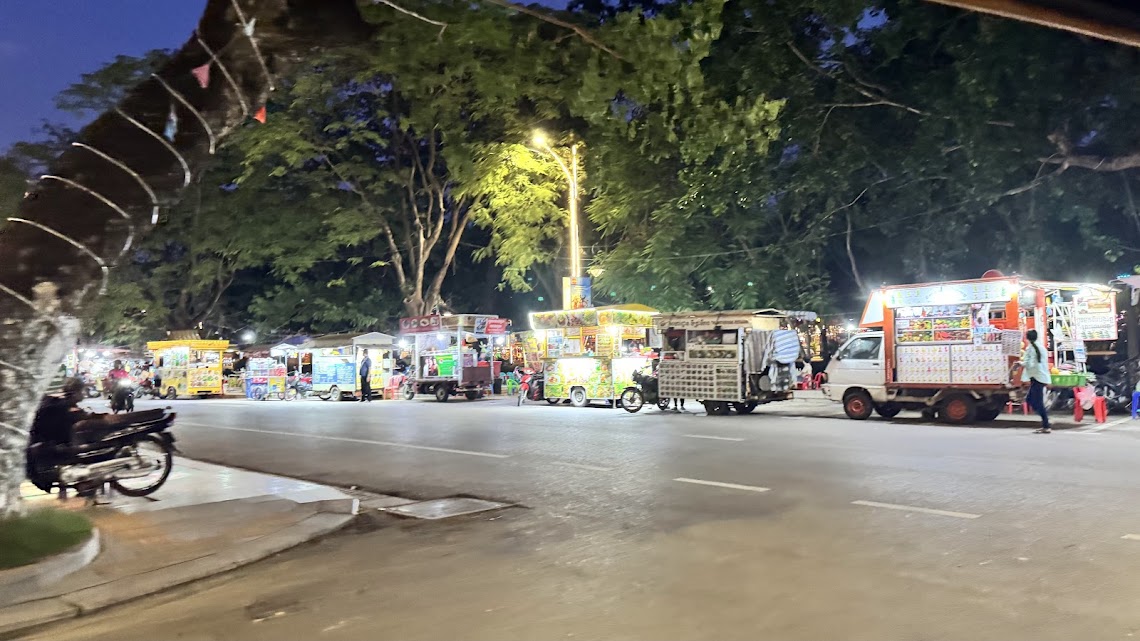
Remember to be wise and stick to cooked foods, avoid things with flies or that have been sitting in the sun all day, and clarify that the ice is filtered water.
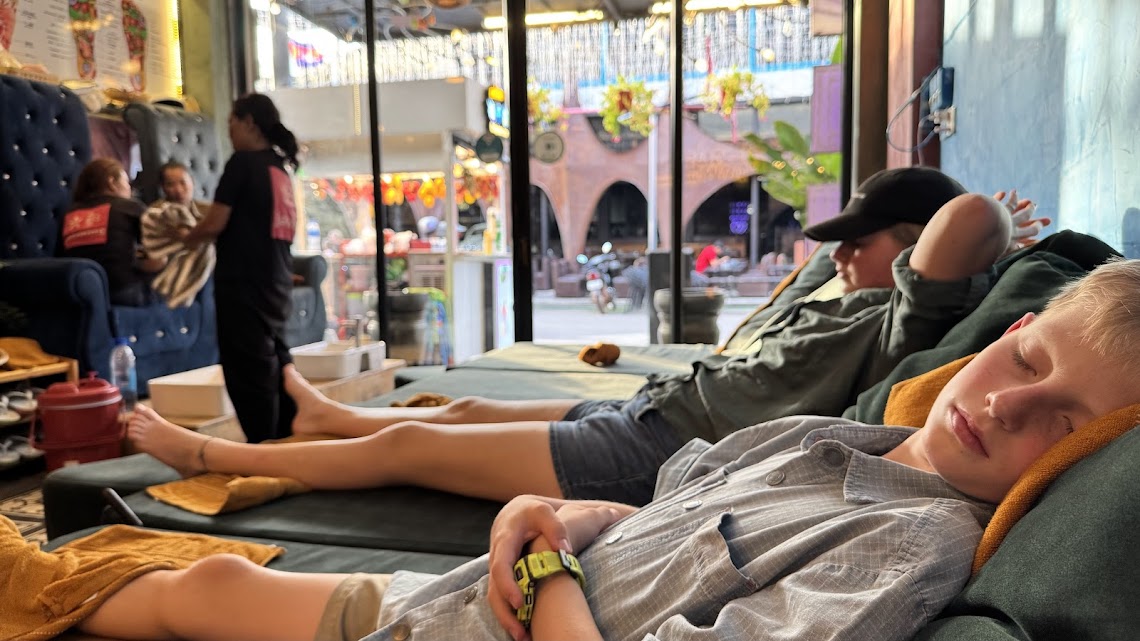
Pub Street is the beating heart of Siem Reap’s nightlife, a lively contrast to the serene temple visits that fill the day. This particular part of town is famous at night and family-friendly in the early hours.
We went to the Robam Pub for dinner and the free Aspara dance (if you buy food). We enjoyed it! The dance is not super engaging for kids, but really cool to see and we liked the food.
Pro Tip: Contact them on Facebook to reserve a spot; they gave us front row seats.
We also did foot massages and fish pedicures while in Pub Street, which was hilariously fun. Core memories!
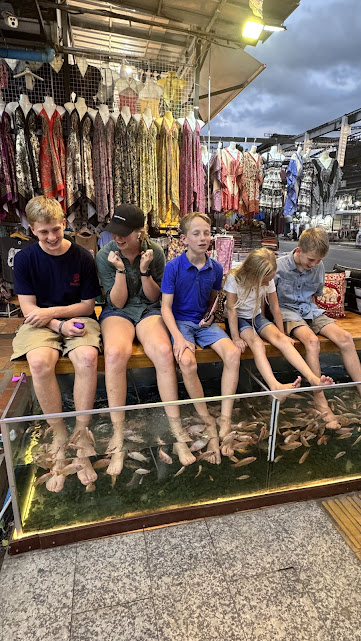
Arriving in the early evening between 5:00 p.m. and 7:00 p.m. means smaller crowds, easier seating at restaurants and plenty of happy hour deals; some bars even serve draft beer for just 50 cents.
If you prefer the high-energy scene, head there from 8:00 p.m. until midnight, when the street is at its liveliest with music, dancing and a full-blown party atmosphere.
Seasonally, the dry months from November to February offer the most comfortable weather for enjoying outdoor seating, though they’re also the busiest. Pub Street, however, doesn’t sleep with the seasons. You can visit any time of year, just be prepared for a sudden downpour during the rains.
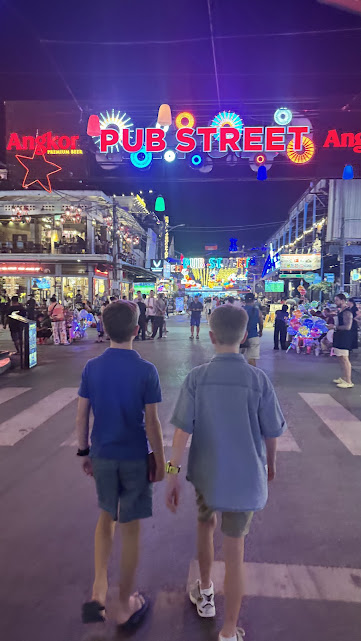
While the main stretch of Pub Street is the star, venturing into the surrounding alleys and side streets reveals quieter bars, hidden restaurants and more traditional spots with a laid-back feel.
Come hungry and thirsty because the area is a food lover’s paradise: You can savor Cambodian classics like Amok or Lok Lak, sip a “Tomb Raider” cocktail at The Red Piano or take a daring bite of fried insects from a street vendor.
Just a short walk away, the Siem Reap Night Market is perfect for shopping, where bargaining is part of the fun and an essential part of the experience.
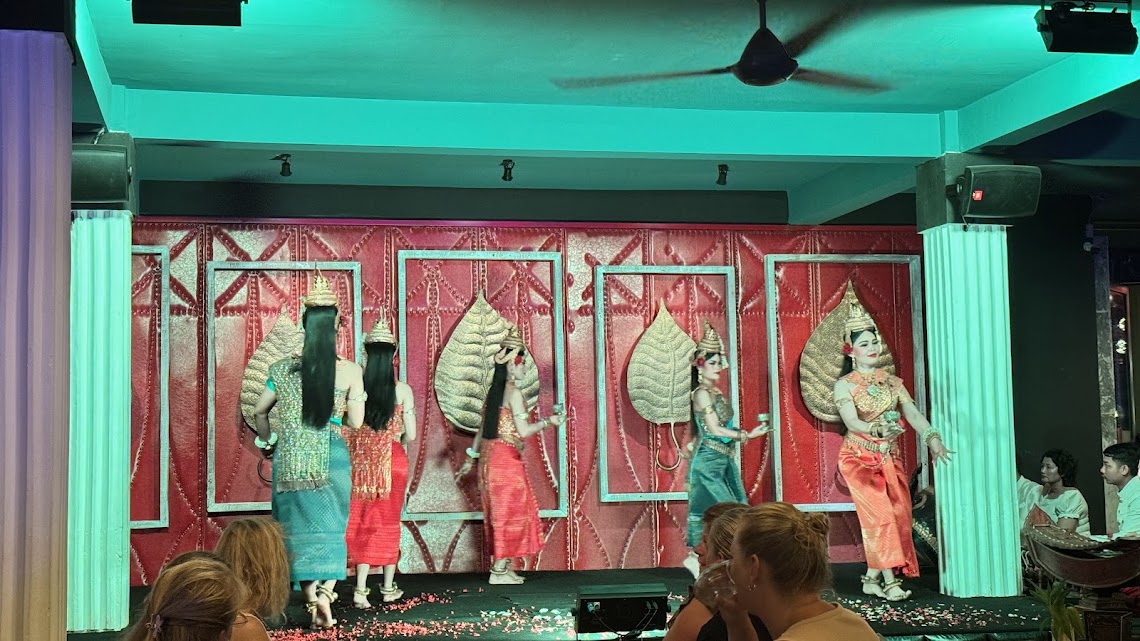
Live entertainment is everywhere; many bars host local bands, while some restaurants feature traditional Apsara dance performances and street performers keep the atmosphere electric. Pub Street is generally safe, but as with any bustling nightlife scene, it’s wise to stay aware of your surroundings, keep an eye on your belongings and pace yourself with the cheap drinks.
With various packages to enjoy, this circus looks super fun! You can combine with a spa visit or VIP access to meet some of the performers.
Phare, The Cambodian Circus is a breathtaking fusion of theater, music, dance, acrobatics and storytelling, brought to life by talented artists from the Phare Ponleu Selpak non-profit school. More than just entertainment, it is a social enterprise that funds art, music and performance education, creating opportunities and support for disadvantaged Cambodian youth. Watching the show means you’re not only enjoying an unforgettable performance but also directly contributing to a meaningful cause.
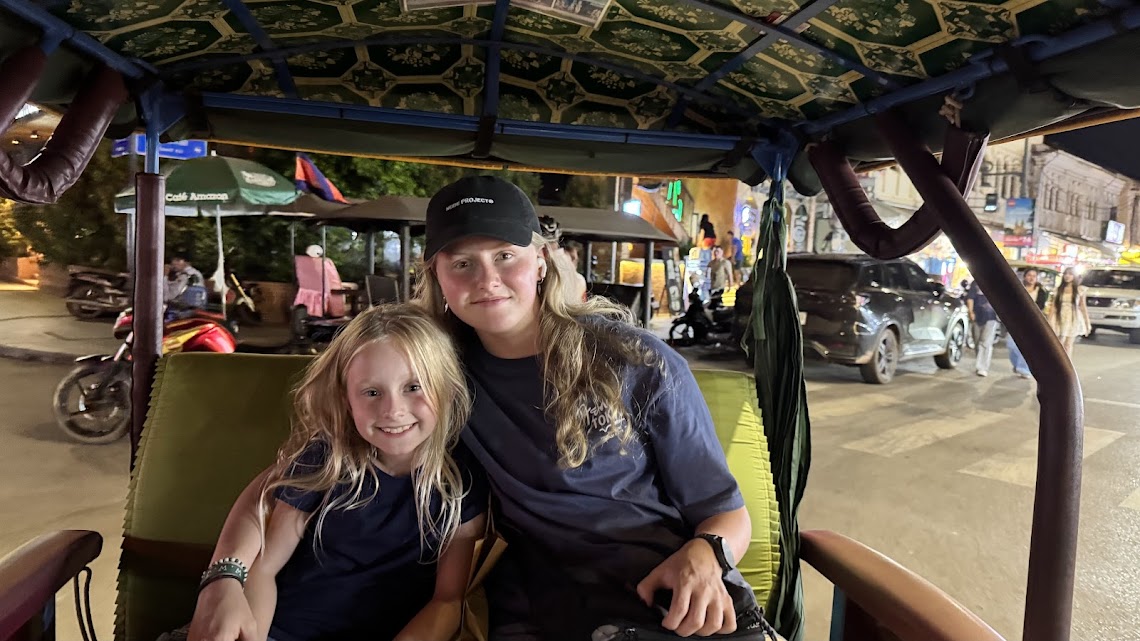
Tickets are offered in three seating sections, each priced to support the school’s mission.
Section C is the most budget-friendly option, with general open seating on the side, usually around $18 USD for adults.
Section B, located at the back of the central section, offers a better view for about $28 USD.
Section A is the premium reserved area, with the best seats in the front rows, priced at around $38 USD, often including a complimentary bottle of water.
You can purchase tickets online through the official Phare Circus website or via travel agents and hotels. Because shows frequently sell out, especially between November and April, it’s best to book in advance.
The main show is performed nightly at 8:00 p.m. and runs for about an hour. Doors open at 7:30 p.m., but arriving at least 30 minutes early ensures a smoother experience and plenty of time to settle into your seat. For those who want to extend the evening, the Phare Café and Phare Boutique open as early as 5:30 p.m. Here you can enjoy Cambodian street food, sip on refreshing drinks or browse locally crafted souvenirs before the performance begins.
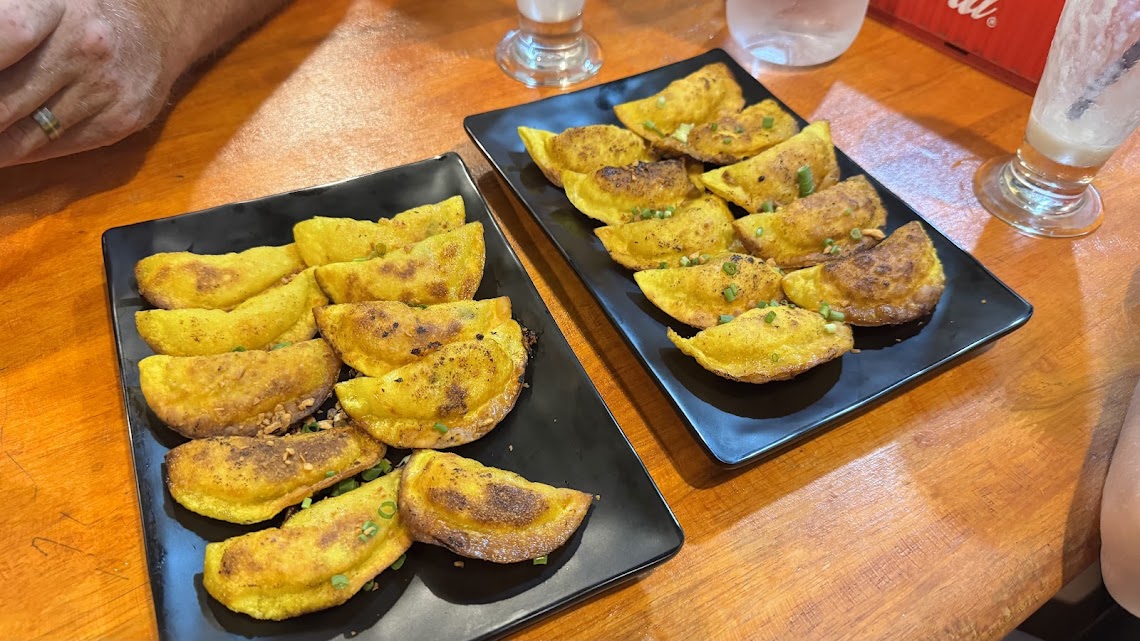
Arriving early allows you to enjoy the lively pre-show atmosphere, complete with live music and performers, as well as time to explore the gift shop and grab refreshments.
Choosing your seats carefully can also make a difference. While the intimate size of the big top means every seat offers a good view, the higher tiers guarantee the best perspective.
If you’re on a budget, early arrival for Section C seating can still secure an excellent spot.
Keep in mind that the big top is not air-conditioned, so dressing in comfortable, breathable clothing and applying mosquito repellent will make your evening more enjoyable.
Photography is generally permitted, but be sure to switch off your flash to avoid distracting the performers and fellow audience members.
Finally, remember that your ticket does more than buy you a seat. It supports a powerful mission, giving deeper meaning to an already unforgettable night.
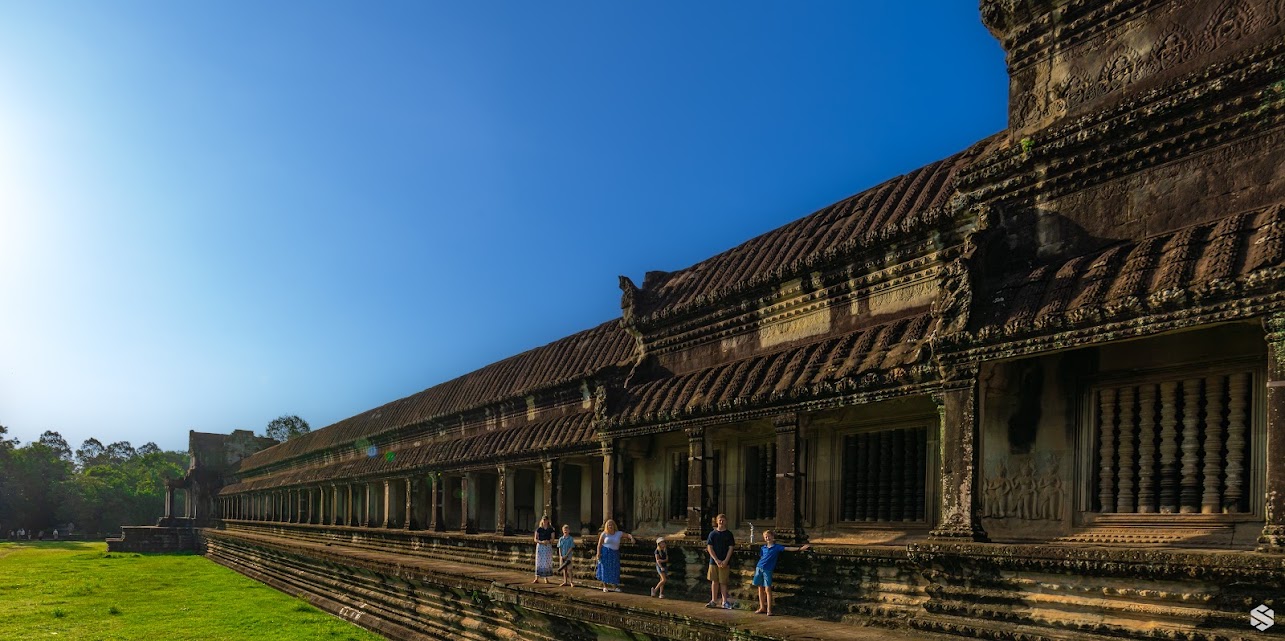
A visit to Angkor Wat deserves its own post, so read all about our experience and our tips here. However, some quick tips:
* I recommend visiting for sunrise. Going early helps with the heat and it is so beautiful.
This small-group tour of Angkor Wat invites travelers to experience the magic of either sunrise or sunset at Cambodia’s most famous temple, followed by guided visits to nearby highlights including Angkor Thom, Ta Prohm and Banteay Kdei. Over the course of eight to nine hours, a local guide leads the journey, offering fascinating stories about Khmer history, culture and architecture while ensuring the tour flows at a comfortable pace.
The experience is designed to be convenient and accessible, with hotel pick-up and drop-off, cold water, towels and entry tickets all included. Starting at just $15 USD per person, it’s an affordable way to explore Angkor’s wonders in depth, combining memorable views, cultural immersion and expert guidance in one seamless experience.
A visit to the floating villages on Tonle Sap Lake provides a unique look at a lifestyle entirely shaped by water.
As the largest freshwater lake in Southeast Asia, Tonle Sap experiences significant seasonal changes. Its communities have learned to adjust in impressive and clever ways.
Watching daily life unfold on the water, such as children paddling to school, fishermen hauling their nets and families cooking in floating kitchens, deepens your appreciation of this resilient culture.
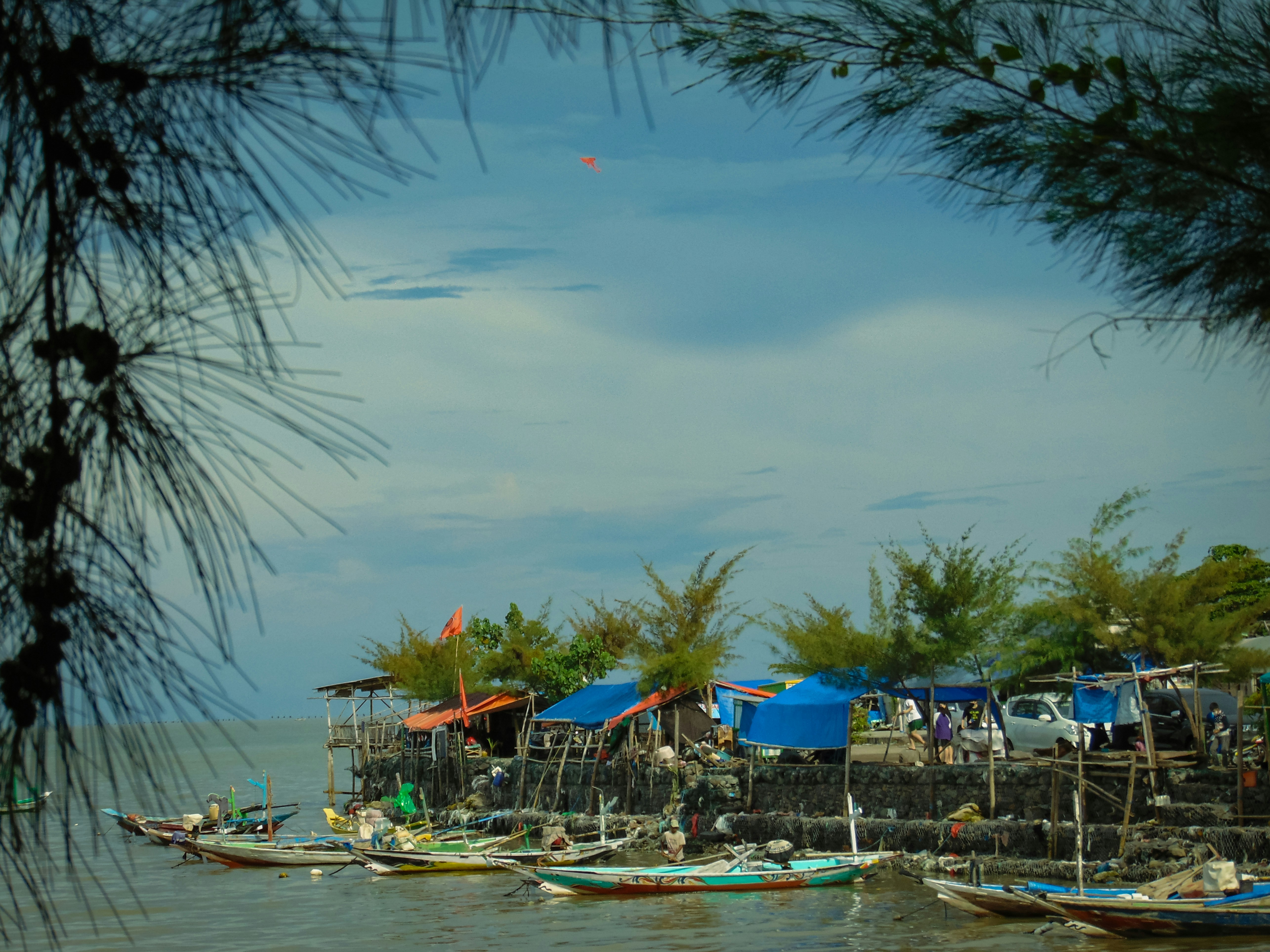
Each village offers a unique experience. Chong Khneas is the closest and easiest to reach; it is also the busiest and most commercial.
Tourists enjoy boat rides that navigate the lively waterways. Kampong Phluk is a popular choice for those looking for authenticity. It is known for its tall stilted houses and the flooded mangrove forests that can be explored by canoe during the wet season.
For an even more genuine experience, Kampong Khleang is farther away and sees fewer visitors. It reveals a large self-sufficient community that feels far removed from the tourist trail.
Tour prices vary based on the village you choose, the length of your visit and whether you go for a group or private trip. Costs typically range from $17 USD to over $60 USD per person. These usually include hotel pickup, boat transportation and the guidance of a local expert.
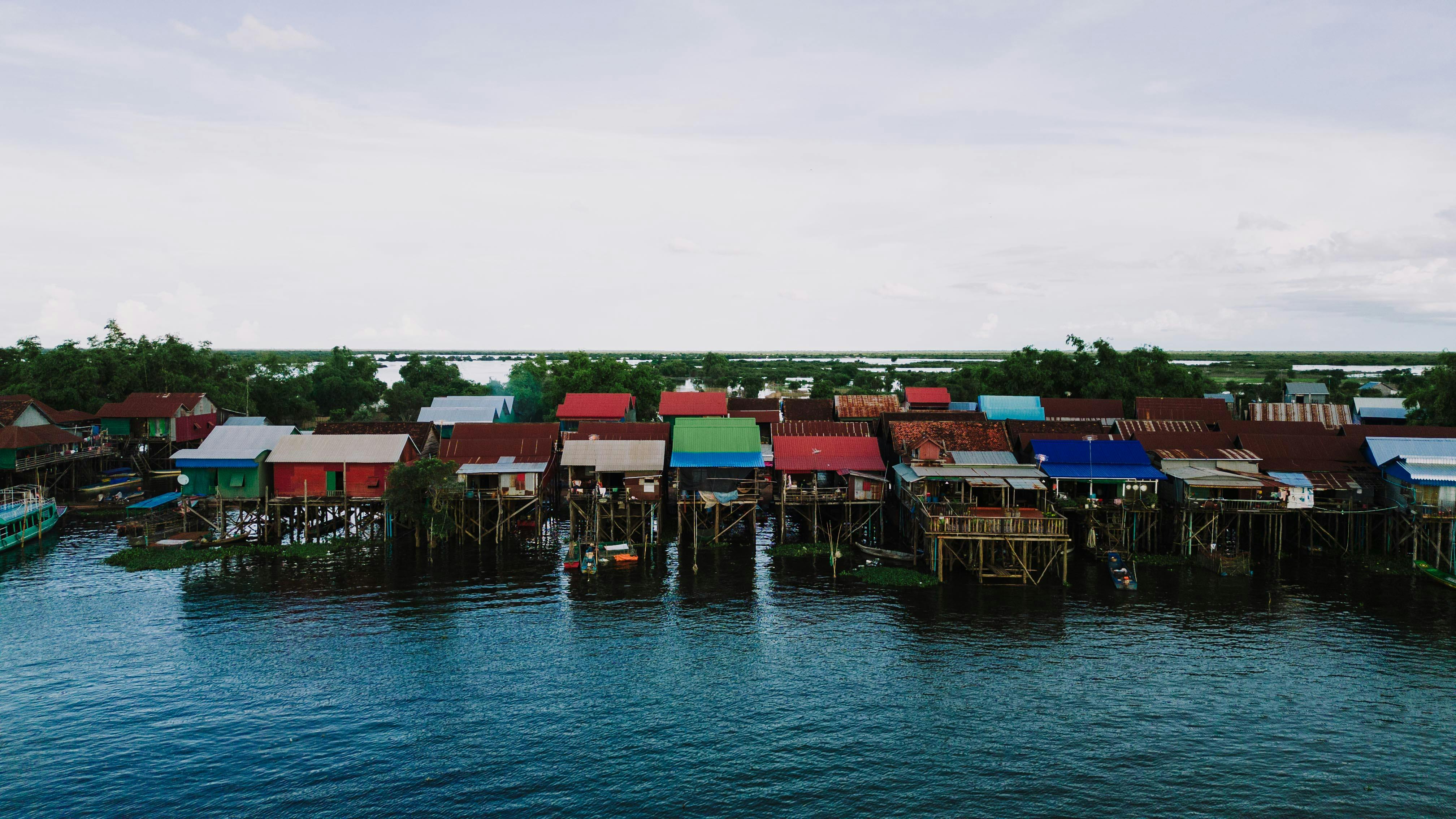
The experience of the floating villages changes a lot with the seasons. During the wet season, from June to October, the lake rises and the villages seem to float. Boats move through flooded forests, and the stilted homes look like they rise directly from the water. This is a beautiful sight, and the wet season is the best time for photography.
In the dry season, from November to May, water levels drop, exposing the tall stilts that support the houses. This change reveals a different landscape. Villagers can be seen biking or walking along the dry ground, giving a clearer view of their clever architecture and daily routines.
For a truly memorable visit, consider going in the evening. Watching the sun set over the lake, with the sky mirrored in the water, creates a peaceful beauty that stays with you long after the trip ends.
Choosing the right village is important for your experience. For convenience, Chong Khneas is the easiest choice. Kampong Phluk and Kampong Khleang offer a more authentic and less crowded perspective for those willing to travel a bit farther.
Traveling with a knowledgeable local guide can enhance your understanding of the communities and their history. This gives context to the traditions you observe.
Respect is crucial. These villages are living communities, not staged attractions. Always be mindful of privacy and ask for permission before taking photos.
Practical preparation also makes the trip more enjoyable. The sun can be intense on the water, so bring sunscreen, a hat and plenty of drinking water. It’s helpful to have some small bills for local purchases. Lastly, consider booking with a tour operator that collaborates directly with the communities.
Supporting social enterprises helps ensure your visit enriches your experience and provides real benefits to the villagers.
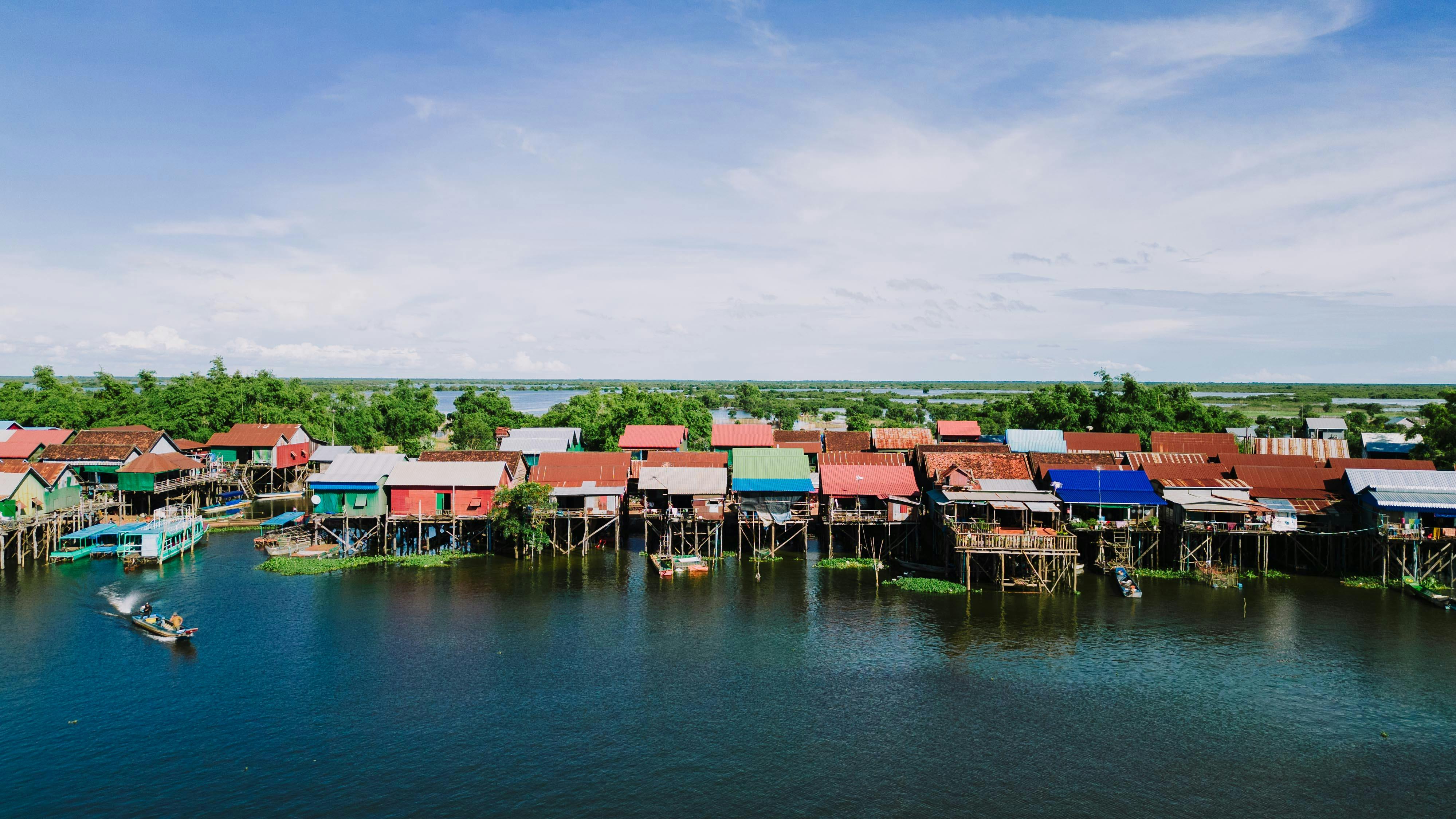
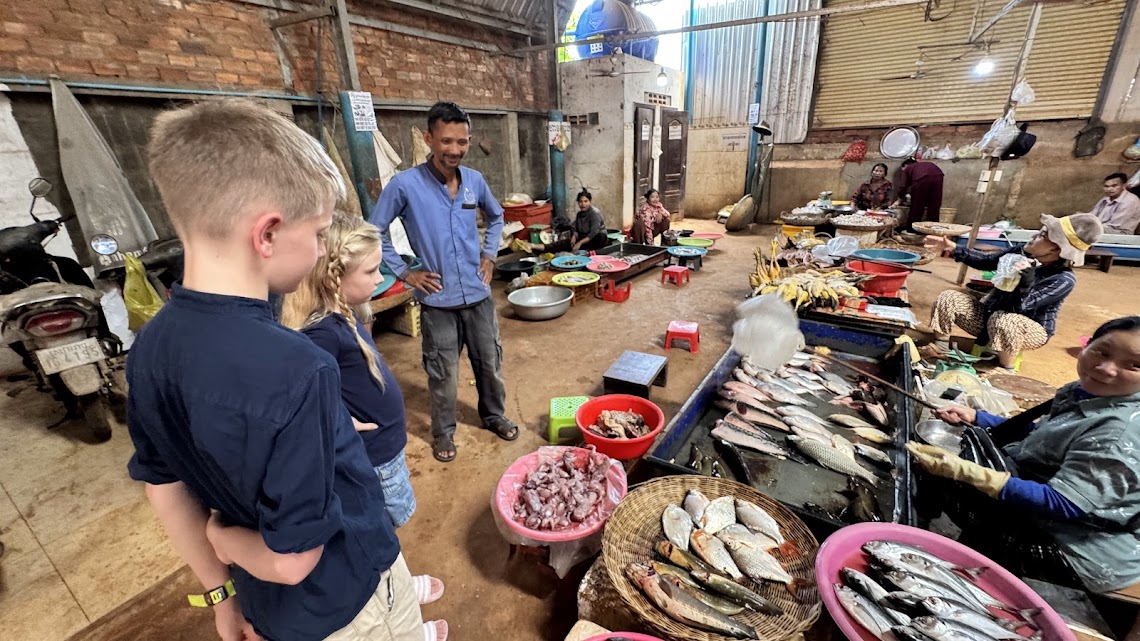
Although we didn’t have the chance to volunteer with REACH Siem Reap during our trip, we think it’s a wonderful idea for anyone looking to give back while in Cambodia.
The organization welcomes volunteers who can offer just a few hours or even a full day, with opportunities to support ongoing projects like food distributions.
Since REACH is a small, community-driven initiative, it’s best to contact them directly via their website or social media to learn about current needs and arrange your visit in advance. Flexibility is important, as their priorities shift depending on the immediate needs of local families.
A visit to the Lotus Silk Farm provides a calm and intriguing look at how one of the world’s rarest and most sustainable fabrics is made. Here, the careful craft of turning lotus flower stems into silk becomes real. The process is beautiful and good for the environment. It combines tradition, skill and new ideas into a unique experience.
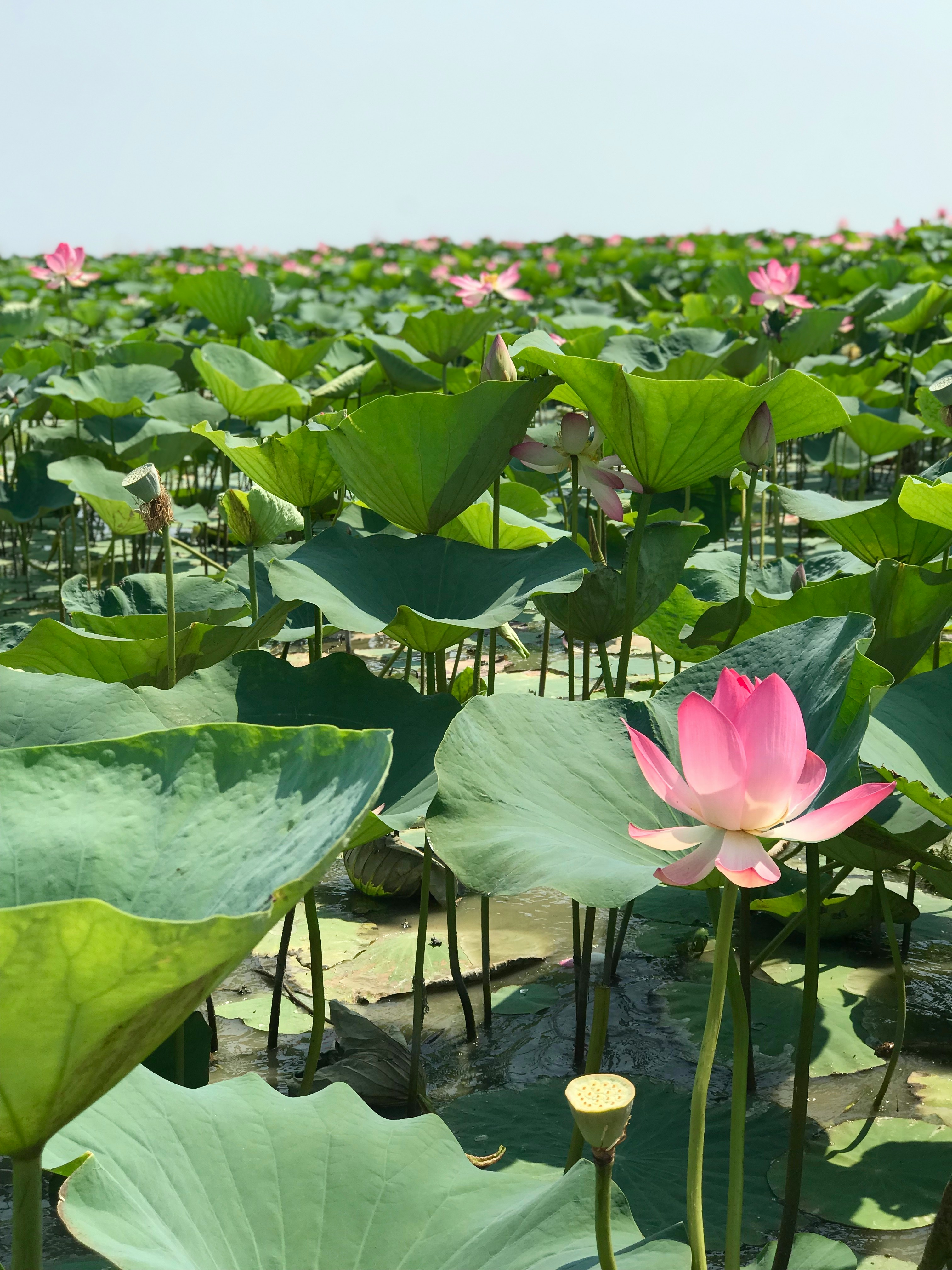
Visiting the Lotus Silk Farm is completely free. Friendly, knowledgeable guides lead tours and are eager to share their expertise.
The farm believes that visitors will be inspired by what they see and will want to take home a scarf or another piece made onsite. These purchases support the farm and help the artisans make a living. Scarves range in price from about $20 USD to over $100 USD, depending on their size and complexity. This pricing reflects the care and effort put into each one.
The farm is open daily, but the time of your visit can shape your experience. Early mornings or late afternoons are the most pleasant, allowing you to avoid the midday heat while enjoying the best natural light for photos.
Because it is a popular stop for tour groups, arriving earlier in the day also means fewer crowds and a more tranquil atmosphere. To watch the artisans in action, plan to visit during regular workshop hours, typically between 9:00 a.m. and 4:00 p.m.
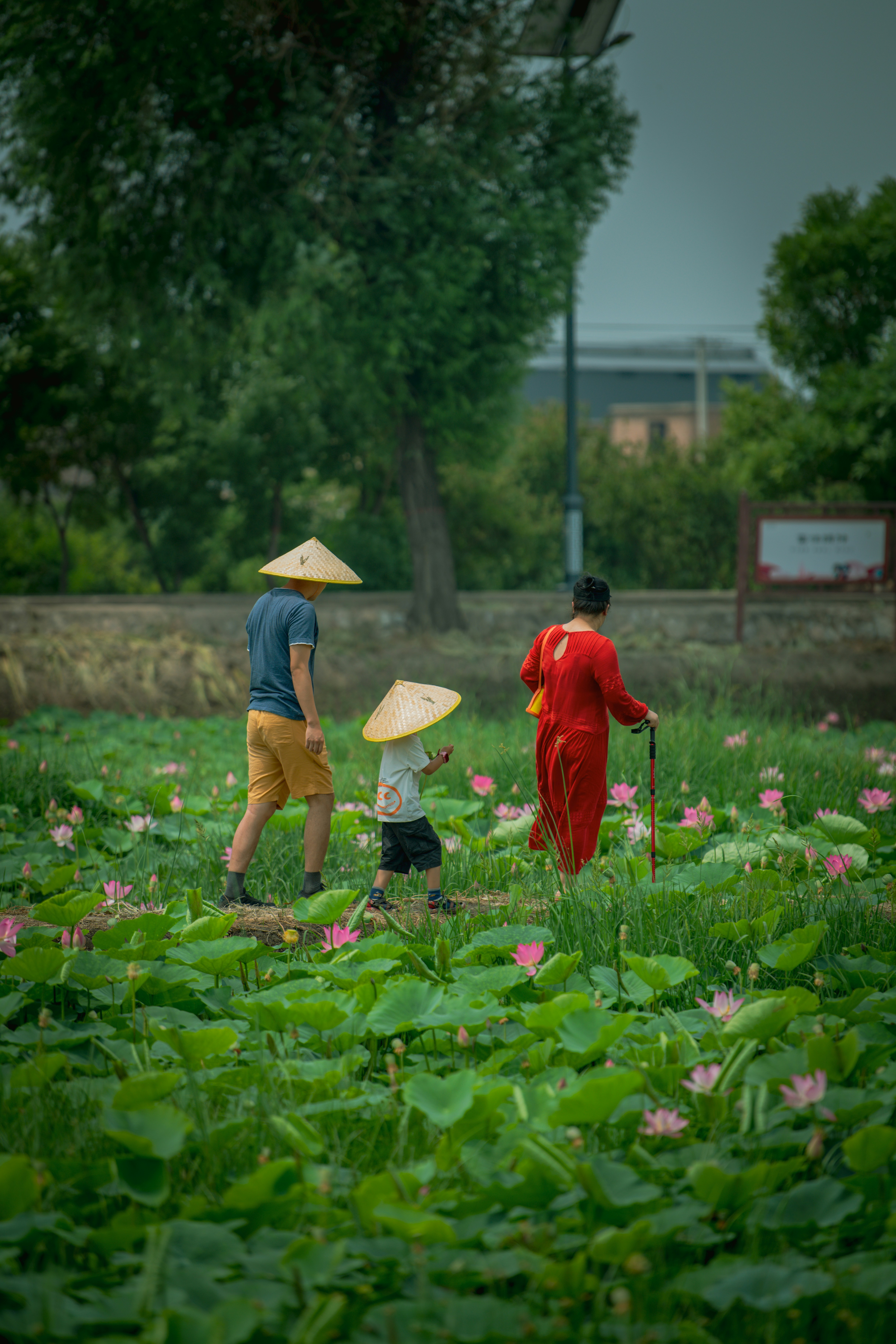
The guided tour is the heart of the experience. It takes you step by step through the remarkable journey from lotus stem to finished fabric. The guides are passionate and friendly, eager to answer your questions as you move from station to station. Along the way, you’ll see artisans at work, splitting and rolling fibers, spinning thread and weaving delicate patterns on wooden looms. Watching a weaver in action is mesmerizing. The quiet rhythm of skill and patience shows the extraordinary dedication behind each piece.
The tour also helps you appreciate lotus silk itself. You’ll learn that it takes fibers from thousands of lotus flowers to create a single scarf, making it one of the most labor-intensive textiles in the world. This understanding adds meaning to the beautiful products you’ll find in the gift shop. Each scarf or accessory is both a keepsake and a way to support the farm’s mission.
Finally, don’t forget to enjoy the beauty of the surroundings. The lotus ponds, intricate looms and finished pieces all make for great photographs. Just be sure to ask for permission before taking close-up shots of the artisans, as their work deserves admiration and respect.
For a unique blend of adventure and nature, Angkor Zipline offers an adrenaline-pumping activity in Siem Reap. Located inside the UNESCO World Heritage-designated Angkor Archaeological Park, this eco-adventure lets you experience the ancient rainforest from high above, combining thrilling ziplines with breathtaking scenery.
Angkor Zipline offers a variety of tour packages, with prices depending on the course you choose. The Silver Eco-Adventure Tour is the shorter option, featuring several ziplines, sky bridges and a rappelling descent. For those looking for a more extensive adventure, the Gold Eco-Adventure Tour includes longer ziplines, additional sky bridges and a larger course overall.
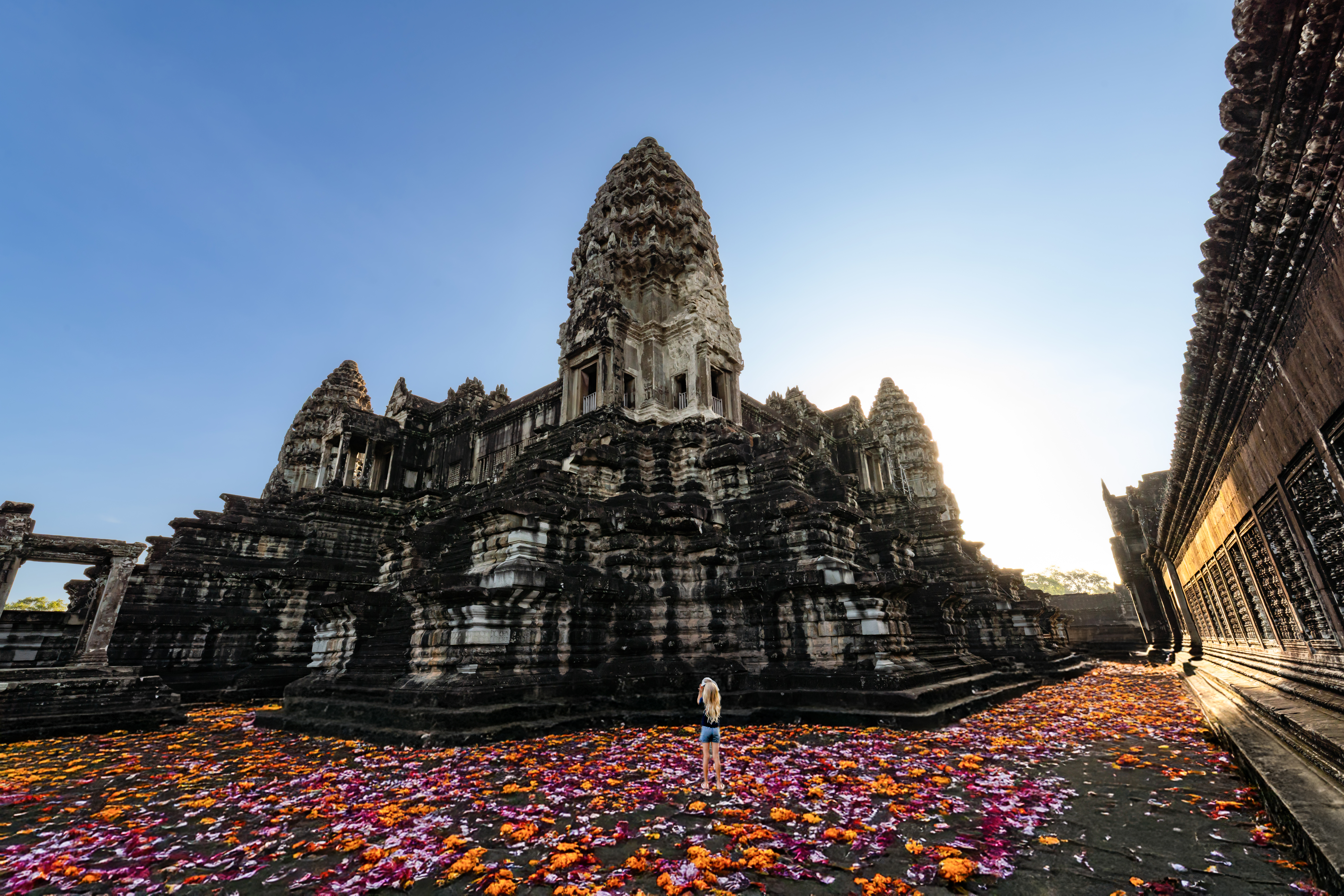
It’s important to note that tickets for the zipline do not always include transportation. You can arrange your own, such as taking a tuk-tuk, but you will need a valid Angkor Park Pass to enter the archaeological park. Alternatively, Angkor Zipline can organize transportation for an extra fee, often bundled with the park pass to simplify logistics. Booking in advance is highly recommended, especially during peak season, and reservations can be made through their official website or major travel agencies.
The zipline operates throughout the day, with multiple tour times available. Early morning is the best time to go if you want to avoid the heat and larger crowds, and you may even have a better chance of spotting wildlife.
In terms of season, the dry months from November to April offer the most comfortable weather, with less humidity and fewer chances of rain.
However, the rainy season between May and October has its own charm, with a lush, green jungle and short but refreshing downpours that rarely last the entire day.
Many visitors also like to combine the zipline with temple visits, starting the morning with an adrenaline rush in the trees and then spending the afternoon exploring Angkor’s ancient wonders.
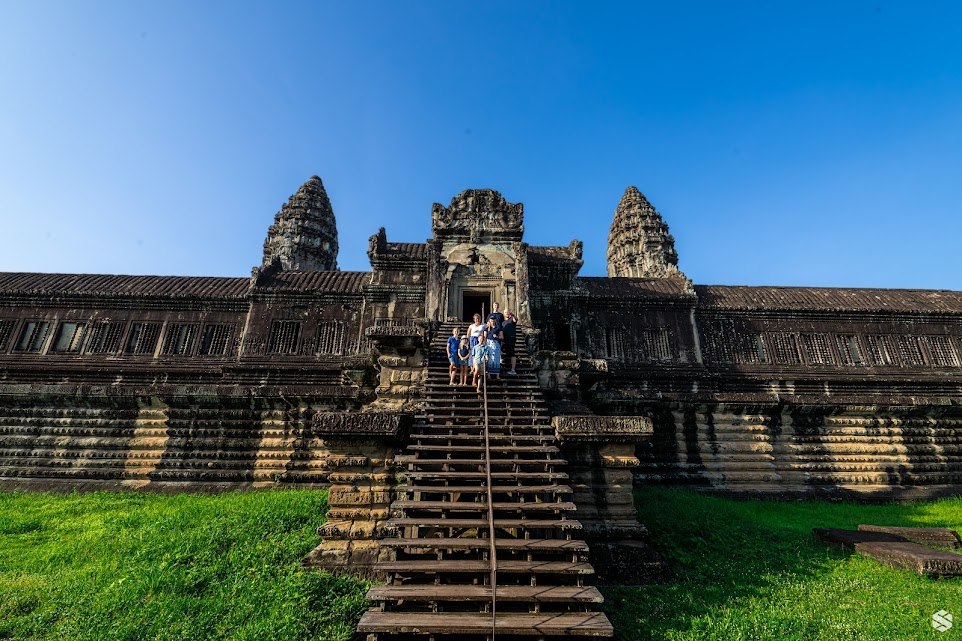
During your tour, make sure to listen closely to the guides, known as “Sky Rangers.” They are experts in safety and also provide fascinating insights into the local flora and fauna, often pointing out wildlife such as gibbons. To stay comfortable, bring water, wear breathable clothing, closed-toe shoes and don’t forget mosquito repellent.
Although the zipline is within the Angkor Archaeological Park, regulations prevent the lines from being built above temple height, so you won’t get an aerial view of Angkor Wat. Instead, you’ll enjoy an incredible perspective of the dense rainforest surrounding it.
If you’re looking for a simple and fun way to cool off, Water Park Khnar Siem Reap is a favorite spot among local families. Located away from the busy city center, the park offers a relaxed atmosphere that’s perfect for a casual day out.
Entry is very affordable, usually just a few dollars per person. The park runs on a card or coupon system where you load money in advance to pay for food, drinks and activities. This makes it easy to manage your spending while enjoying everything the park has to offer.
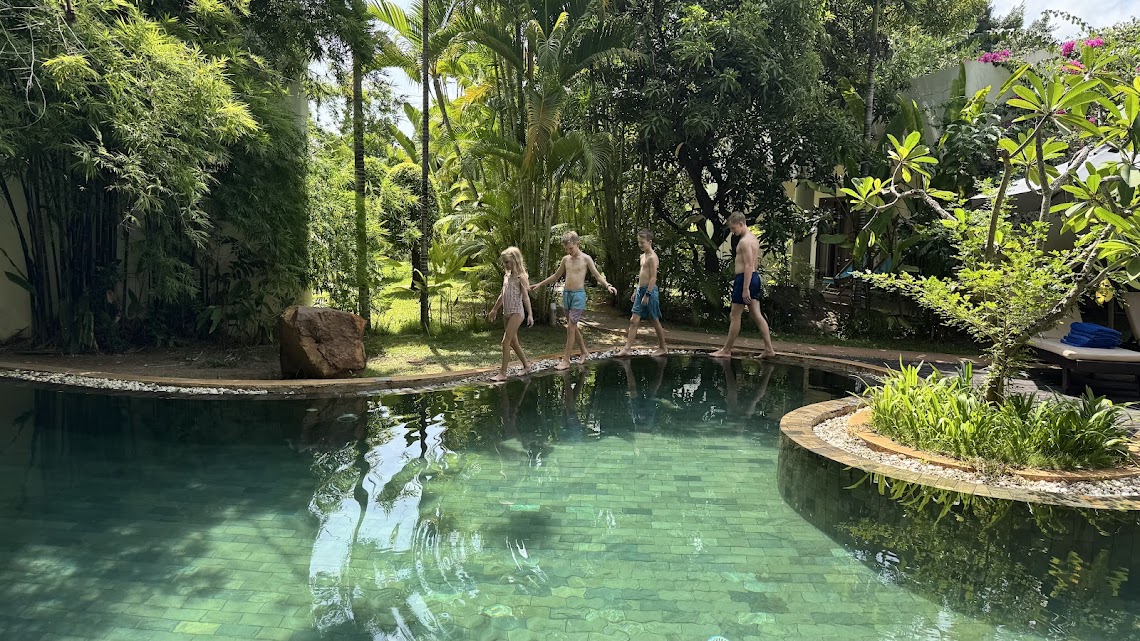
Weekends tend to be the busiest, as many local families head to the park to escape the heat. For a quieter and more relaxed visit, weekdays are a better choice. The park is also at its most crowded in the afternoons, so arriving in the morning or early evening not only avoids the rush but also helps you secure a good spot, such as one of the private bamboo huts for lounging.
Water Park Khnar isn’t about massive attractions or adrenaline-pumping rides; it’s all about simple, laid-back fun. You’ll find a few swimming areas and basic water slides that kids love.
To get the most out of your day, bring along your own towel and enjoy a very local experience. Don’t miss the onsite restaurants, which serve tasty and affordable Khmer-style dishes and refreshing drinks.
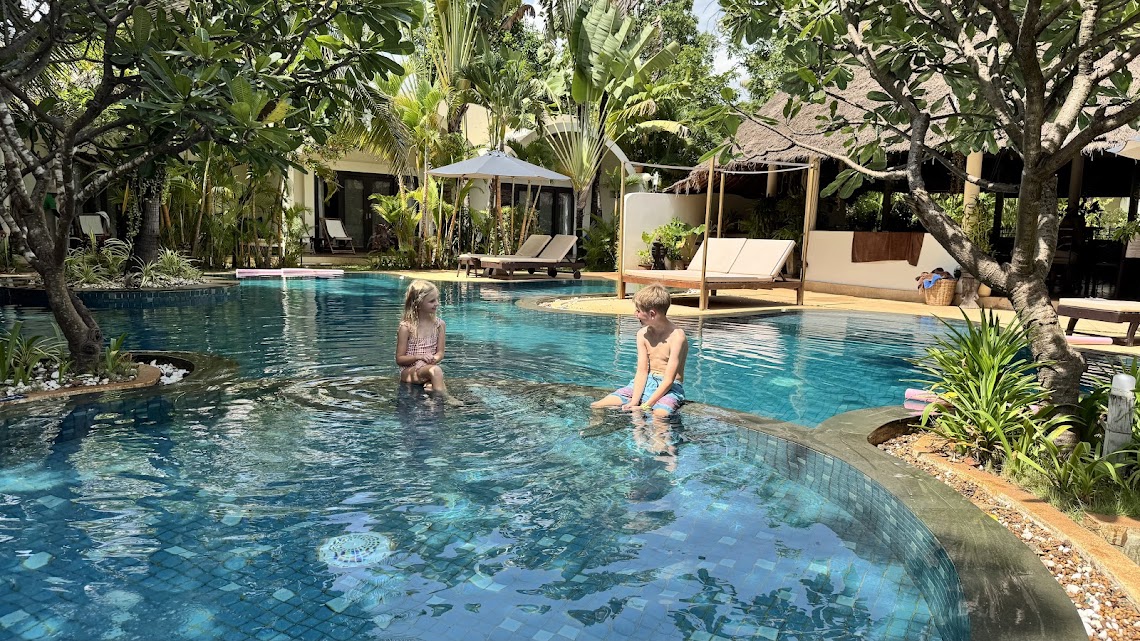
Planning a trip to Siem Reap with kids can be exciting and rewarding, especially if you find the right place to stay. Here are three distinct options that each offer something special, along with what families can expect and typical nightly rates.
Navutu Dreams Resort & Wellness Retreat is a great choice for families looking for peace and space away from the busy city. While it is known as a wellness sanctuary, it also accommodates families well.
Kids will enjoy the three swimming pools, including one just for them. Meanwhile, parents can relax in the beautiful gardens or use the wellness facilities. The family suites are designed with separate rooms, providing privacy and comfort for everyone. To make your stay easier, the resort offers babysitting services for a small fee and can organize family-friendly tours.
We truly loved our stay there! The food was excellent and we all loved the onsite cooking class that we did.
Rates typically range from $80 USD to $170 USD per night, with even lower prices during the off-season.
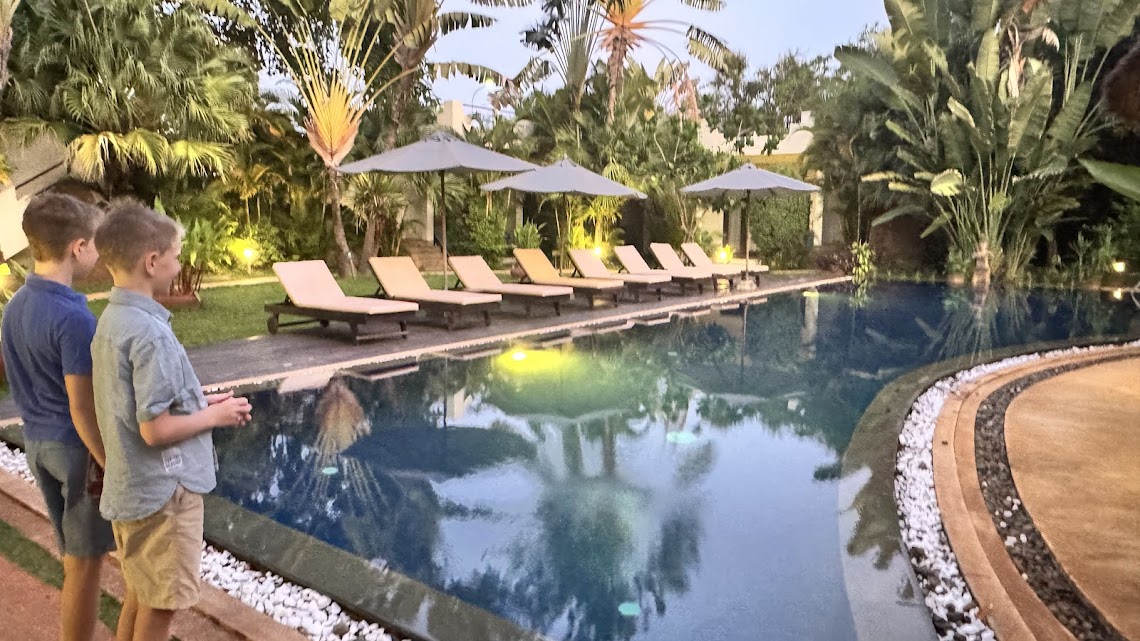
For families who prefer boutique luxury, Jaya House River Park Hotel offers a refined experience in a great location. Situated along the Siem Reap River, it blends tranquility with easy access to attractions like Pub Street and the night markets, which is a convenient option for families with young children. The hotel is known for its outstanding service and strong commitment to sustainability. With two beautiful pools, including a saltwater option, both adults and children can enjoy relaxing downtime.
Families will appreciate the welcoming atmosphere and the help with planning activities. As a high-end boutique hotel, nightly rates usually range from $250 USD to $400 USD.
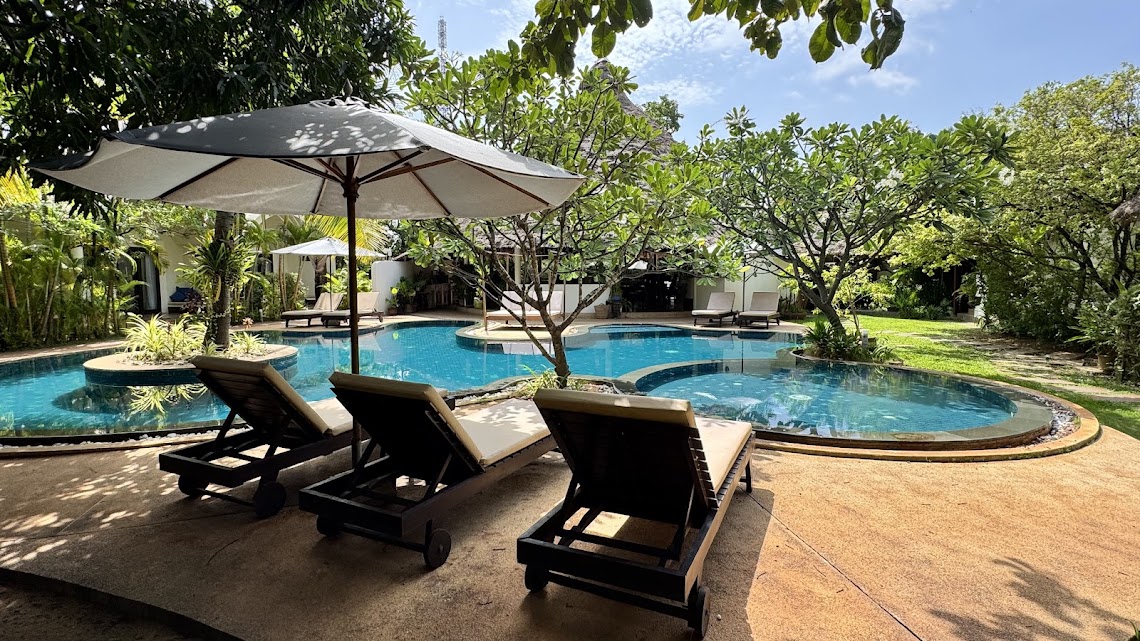
Lotus Blanc Resort is an excellent choice for those who prefer a larger resort with plenty of amenities. Its spacious rooms and suites are especially suited for families, and the large swimming pool is a hit with children. With various on-site dining options, a spa, and a kids’ club, the resort makes sure that everyone finds something enjoyable without needing to leave the property. Its slightly out-of-town location provides a more laid-back feel while still keeping attractions within easy reach.
With nightly rates between $50 USD and $90 USD, Lotus Blanc offers a budget-friendly way to experience resort-style luxury.
Whether your family values peace and wellness, boutique charm with a focus on sustainability, or the convenience of a full-service resort, the right choice depends on the pace and style of your family’s ideal Siem Reap adventure.
Siem Reap is so much more than just the gateway to Angkor Wat. While the temples are undoubtedly a highlight, the city offers families an incredible mix of culture, adventure, and unique local experiences.
From meeting HeroRATs at APOPO and wandering lively night markets to ziplining through the rainforest or cooling off at a water park, there are multiple ways to keep both kids and parents entertained in Siem Reap.

Check out your travel necessities from a comprehensive list of all the 7Wayfinders Travel Must-Haves. Click Here!
Find a nice hotel near Siem Reap from Expedia, or Vrbo, (we also love Tripadvisor and Hotels.com)
Discover more of Siem Reap while having fun through exciting activities from GetYourGuide, Airbnb Experiences, or Viator
Need to rent a car to navigate the city? Visit Rentalcars.com.
Get insured while traveling with World Nomads / SafetyWing
Want to have a photo shoot while traveling? Check out flytographer!
Capture your best memories in Siem Reap as we do with a GoPro, Sony camera, or our favorite drones: DJI FPV, Air, and Mini
Check out your travel necessities from a comprehensive list of all the 7Wayfinders Travel Must-Haves. Click Here!
Best International Travel Apps When Traveling to Asia with Kids
Angkor Wat with Kids: Make Your Family Visit Unforgettable
